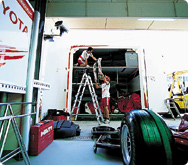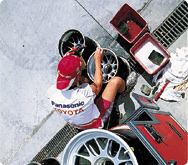|
There are boxes everywhere - 96 of them to be precise - some large, some small, most fairly anonymous, save for the odd Toyota logo and an identity badge. Yet in them nestles more than 40 tonnes of state-of-the-art Formula 1 racing hardware, including three chassis and enough spares to build a new car virtually from scratch.(The boxes are stacked on certain pallets, which are transported to the race by air freight. Eight or nine pallets are generally required to move the equipment to an overseas race site.)
One could be forgiven for wondering where to start, but in a few short hours, a handful of people will have assembled the foundations of Panasonic Toyota Racing's home from home, the Cologne factory in miniature.
 |
 |
There are 40 tonnes of components and equipment to load and unload in preparation for each overseas grand prix
|
This advance party of 10 is headed by chief mechanic Gerhard Lecoq, and comprises four mechanics and six 'truckies' - men who would normally drive the team's commodious articulated transporters to the European races. They start building the garage at 8.00am on Monday. The general mood is cheerful and optimistic.
Lecoq's team works from his masterplan, which lists every component part of the garage and tells them in precisely which box it can be found. The plan also has a detailed floor layout of where everything must go.
No Time Can be Wasted at All
 |
 |
The cars stay under wraps until Wednesday.
|
“First we build the gantries that carry all the overhead equipment for the cars,” says Lecoq. “Then we construct the dividing walls of the garage according to the layout designed in Cologne. This splits the garage into separate areas for all the different operations – engines, tyres, composites, telemetry, etc – and helps everyone work as efficiently as possible.”
As with all things F1, preparation is the key. The cars, spares and tools have travelled directly from the race in Malaysia and, before that, Australia. Consequently, the planning for Bahrain all had to take place long before the start of the season.
On day two, reinforcements arrive and the individual operations areas are set up in more detail. The pitwall awning, the team's strategic nerve centre come race day, is also assembled. Meanwhile, any spare hands are kept busy ensuring that the garage and every component is kept spotlessly clean - not just as a matter of pitlane pride, but because even dust particles can compromise performance.
 |
 |
The team focuses on getting everything spotless
|
The cars themselves are left boxed up and virtually untouched until Wednesday, by which time the rest of the team has arrived, the garage is finished and the latest parts have arrived from Cologne. Crucially, this also ensures that no time is lost searching for missing items.
“When you arrive at the track, you can only lose time,” says Lecoq. “You can never gain it. There is no time to get parts from the factory, so everything must be in the right place and go together smoothly. Wasted time only helps your rivals.” |